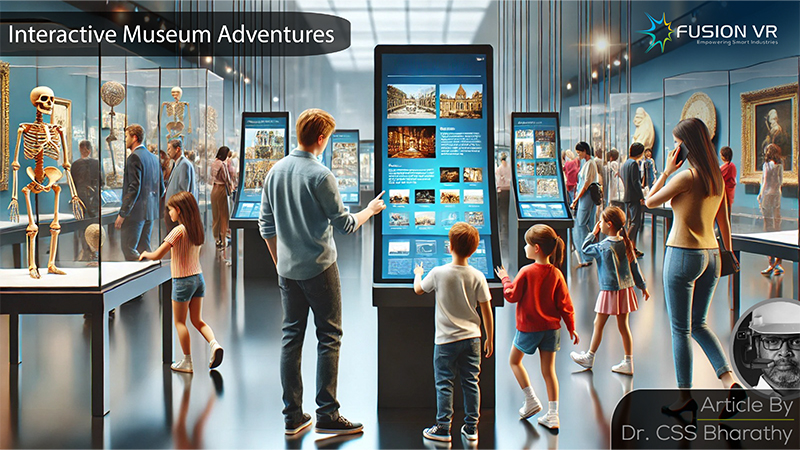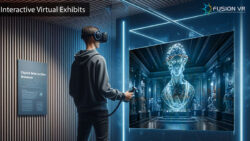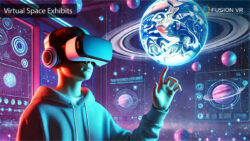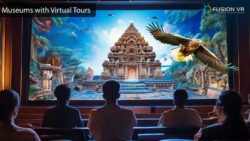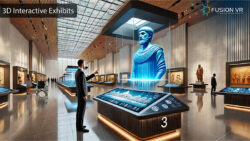Alan Kay, the pioneering computer scientist who worked on truly transformative inventions such as the graphical interface, object-oriented programming, and the personal computer once said, “ The best way to predict the future is to invent it”. Many scientists and engineers have created concepts and ideas that stretch the realms of human imagination and provide the much needed imagination. This has helped people realize that the impossible can be possible. Not many people would have imagined three decades ago that the computing capacity of a personal computer would one day fit in the palm of your hand as a smartphone. It is such imaginative forays into the past that have made the world what it is today.
The same can be said about museums today. Traditional museums which display artifacts and charge a fee for viewing them are quietly fading away. Newer museums are using the latest digital technologies to be more interactive. Traditional museums are also adding new exhibits that are helping them transform into interactive museums. The trends in the museum space are quite exciting and we will explore these in this blog. The technologies in play are getting more advanced and sophisticated. It is also driving cross-functional collaboration from various subject matter experts in the development of interactive museum experiences.
Virtual reality and Augmented reality are the technologies that are playing a major role in the world of interactive museums. There is no question that they will continue to be the key technologies in museums that engage all kinds of visitors and leave with them a memorable experience. Virtual reality is completely immersive and teleports the visitor into a completely new environment. The VR headset is an amazing device that enables the visitor to navigate through the virtual worlds. Virtual reality creates long lost eras in human history in highly realistic 3D digital models that trick the human brain to believe that it is in that space. The movement in this virtual reality space feels the same as in real life and within a short span of time, the visitor believes themselves to be in that environment. This is crucial for delivering amazing VR experiences.
While this VR museum experience is truly magical, it requires the collaboration of many experts to deliver it. The adoption of virtual reality exhibits and experiences is on the rise and the future museums will see an increased number of such experiences. More and more museums will be deploying this to increase the visitor footfall using these technologies. VR exhibits enable a kind of time travel that takes visitors on a journey to witness important historical events. It allows them a ring side view of what and how crucial events unfolded centuries ago. The immersiveness of VR makes the visitor feel that they are actually part of that event. These experiences leave an indelible impression in the minds of visitors, particularly those from the younger generation. The legends of the past have been transmitted through several generations through word of mouth. Only in the last two centuries, we had this captured in print. Virtual reality is helping people of today to leave their imagination aside and see it for themselves on what it would have actually looked like then. This VR experience is what most future museums will feature increasingly in the years to come.
Augmented reality is also fueling the future of interactive museums. More people around the world are using augmented reality without knowing what it is. That is how this cool technology has quietly invaded our lives through a smartphone. If you have played Pokemon Go, you know what I’m talking about. In the museum space, augmented reality helps visitors experience and interact with the various exhibits housed there. Even the walls and passages of a museum are being made interactive. The goal is to make every inch of the museum an interactive and immersive experience for you.
With augmented reality museums applications, future museums will speak to you. The exhibits, paintings and artifacts come alive with the power of AR. This experience can be obtained with the ubiquitous smartphone or a specially designed AR wearable such as a goggle that delivers content overlaid on what you already see. The future is more about wearables and making a seamless experience with digital content and information delivered directly in your field of vision. This is a huge shift from the museum experience we obtain here. It is not uncommon to see people strolling through a museum and checking the box that they have visited or children aimlessly wandering in a museum with little or no guidance from teachers or parents to explain the wonders of the exhibits there.
There is so much to be gained with the use of augmented reality technology towards learning and a better appreciation of the treasures a museum holds. Augmented reality guides will become a standard feature for all museum visitors and this will enable them to receive a highly interactive experience. There is a dearth of knowledgeable guides in museums today. Many historical places like the Red Fort or the Taj Mahal are truly open air museums, where you may find some guides, but the experience is wholly dependent on the individual’s ability to engage and share interesting information. Encountering such a guide is a rarity and this is where AR becomes really useful.
Museum experts, historians, technologists, artists and developers are pulled into a collaborative engagement by expert project managers to create, deliver and curate interesting AR VR museum experiences. Many museums across the world have begun displaying AR exhibits and providing AR VR experience centers. This is the future of museums and the digital generation of today will blend into it without batting an eyelid. The museums of the future are going to be powered by Artificial intelligence (AI) with personalized content and experiences delivered based on your preferences or even your movements in the museum spaces.
Artificial intelligence driven applications will deliver your museum experience in a language that you are most comfortable with. This is very useful when visiting museums in different countries where exhibits may be mostly in English and if you need that information in Tamil or Hindi, your virtual AI museum companion will do that for you. Museums are often large physical spaces that tend to even challenge the physically fit. AI powered museum applications would help you obtain the most interactive experiences with the most optimal route based on your own preferences and health markers. Museums would also be able to tap into the massive data generated by these applications and obtain intelligence on visitor preferences and engage in continually adapting their offerings by adopting a data driven approach. This helps them innovate and stay ahead of the curve to make the best interactive and immersive experiences for their visitors.
This has been an interesting journey as we explored some aspects of what the future holds for interactive museums. There is tremendous interest in India from the governmental and private players to create interactive museum spaces to capture the incredible aspects of our culture, history, religion, politics, science etc. The momentum is significant and solution providers such as Fusion VR are playing a crucial role in not only delivering these interactive experiences to top museums, but also educating stakeholders on the technology choices that are available and emerging. We are developing solutions for AR VR museums and corporate experience centers and delivering projects across the nation.
Overall, the future of interactive museums in India and across the globe is very promising. They are poised to cut across all kinds of barriers and deliver memorable experiences for everyone.

